- ENDEES
- UiU - Home
- Art Destination Jordan
- AD Jordan
- HIGHLIGHTS
- THEMES
- ITINERARIES
- Travel tips & information
- Free Newsletter
- UiU - Sections
- Free Newsletter
For an optimal view of our website, please rotate your tablet horizontally.
The rock-cut facade tombs recorded in Petra sum up to about 628. They were created from the middle of the 1st century BC to 129 AD. Many are part of larger burial complexes, which could include forecourts or platforms, triclinia, cisterns and water basins for cultic rituals. These were meeting places of clans, where, in addition to honoring the dead, festivities and other social activities took place. Most of the rock facades in Petra were covered with light-coloured stucco and painted, which protected the soft sandstone from erosion. In the austere burial chambers, various types of recesses for graves carved into the walls and floors can be found.
In 1897-98 Rudolf Ernst Brünnow and Alfred von Domaszewski mapped and catalogued the monuments of Petra. The numbering in their 1904 publication still serves as a reference today. They also created a first typology of the tomb facades, which can be assigned to three main groups. The drawings here below are taken from their book.
Also called pylon tombs or Assyrian tombs. The walls are often slightly tapered backwards and inwards at the top, reminiscent of pylons of Egyptian sacred buildings. The façade is decorated with one or two friezes of stepped merlons (crowsteps) and a half merlon at each corner with relief mouldings below and above.
The frieze of stepped crenellations was already common in the brickstone architecture of Mesopotamia in the 3rd millennium BC and in Persian art of the 6th/5th century BC. Direct models of the Nabataeans could have been the crenellated friezes of Phoenician-Hellenistic buildings in the necropolis of Amrit (on the Levantine Mediterranean coast in present-day Syria), which were also carved from the rock.
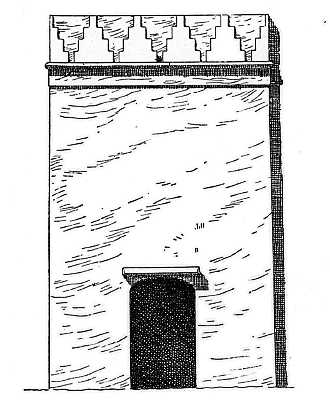
Single Pylon Tomb
Frieze with a row of crowsteps (stepped merlons) over a relief moulding, and sometimes another narrow, plain frieze.
In a horizontal groove above the doors, the names of the tomb owners, a decorative frieze or stone mouldings could have been inserted.
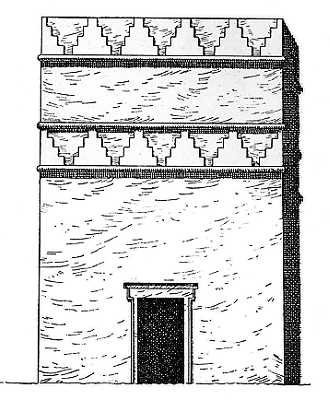
Double Pylon Tomb
Two friezes of crowsteps with relief mouldings above and below.
Other designations: Step-, Proto-Hegra- or Hegra-tombs. A frieze of two monumental staircases facing each other, each with five steps (except for some tombs in Hegra) over a cavetto (concave moulding) cornice, and fascia (horizontal, threefold moulding) crown the façade. The entablature is supported by pilasters, which can be supplemented by quarter columns on the inner sides. The Nabataean horn capitals were probably stuccoed and painted in most cases.
For the difference between Proto-Hegra and Hegra types, see the drawings with short explanations. "Hegra" refers to the second largest Nabataean settlement on the southern edge of their territory, today's Mada'in Salih in north-western Saudi Arabia.
The Nabataeans also adopted and adapted elements from other cultures for these types of façades, such as the steps motif, which already existed in the Assyrian-Achaemenid culture of the 8th/7th century BC. The form of the caveto used by the Nabataeans could have been taken from the Syrian-Phoenician Amrit, just like the crenellated frieze. The double door frames and the pilasters with quarter columns are based on Hellenistic-Alexandrian models.

Step Tomb
Two sets of steps facing each other, over a cavetto (concave moulding) cornice, and fascia (horizontal, threefold mouldings, projecting from bottom to top).
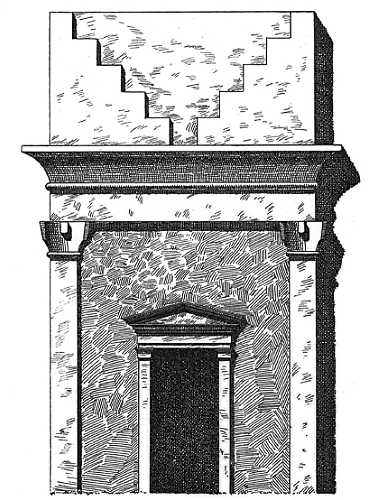
Proto-Hegra
Two sets of steps facing each other, over a cavetto cornice, and fascia. Pilasters with Nabataean capitals support the architrave.
"Hegra" refers to the second largest Nabataean settlement on the southern border of the kingdom, today's Mada'in Salih in northwest Saudi Arabia.
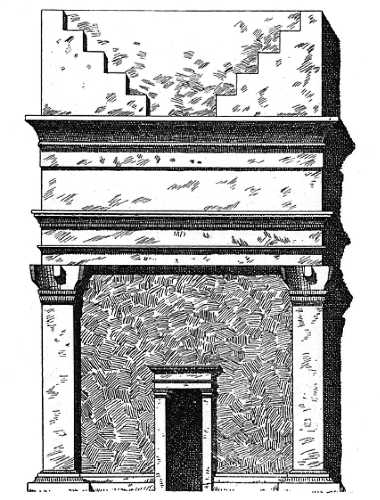
Hegra
Two sets of steps facing each other over a cavetto cornice, and fascia. A non-decorative attic is added above the classical entablature supported by the pilasters. In this attic there are occasionally dwarf pilasters or half or quarter columns.
These monuments, built only in Petra and the surrounding area, are also known as Hellenistic tombs, Roman temple tombs, classical Nabataean or classical Nabataean-Roman tombs because of their elements of Greco-Roman origin. Simple triangular pediments or broken pediments (left open at the apex) form the completion of the one or two-storey rock architecture.
The facades can be structured by more complex arrangements of pilasters, half, quarter and three-quarter columns with Nabataean capitals and adorned with various decorative elements. Often a metope-triglyph frieze is encountered in various forms, and figurative reliefs are also possible. Following the model of the Al-Khazneh (Treasury) a central tholos (round temple) appears in some cases in the center of the broken pediment.
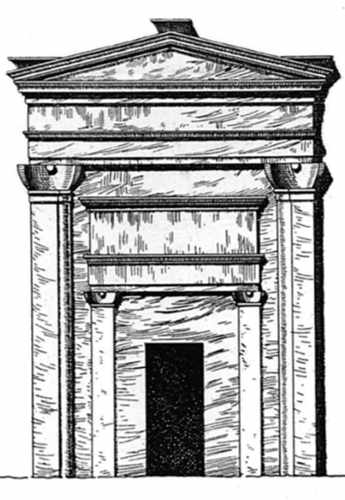
Simple Classical
In the basic structure pilasters with Nabataean capitals under an entablature, above which a triangular pediment rises. The facade can be structured by a doorway architecture with pilasters, capitals and attic or other decorative elements.
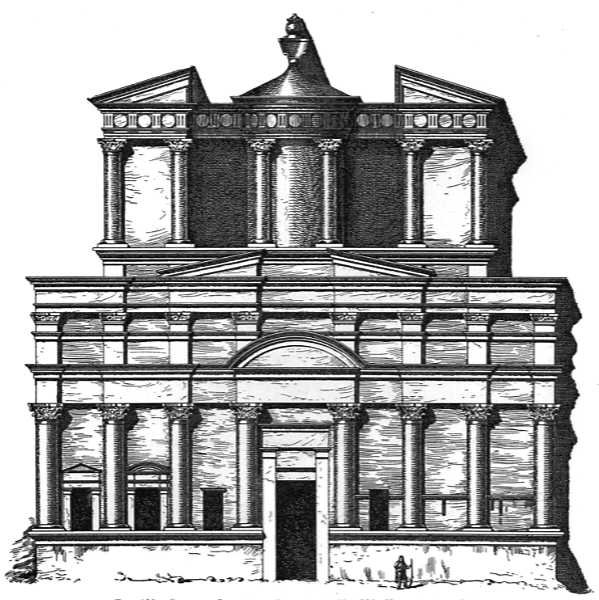
Complex Classical
The basic structure and the variety of architectural and decorative elements are inspired by Hellenistic architecture. The most famous example is Al-Khazneh (Treasury), probably built in the second half of the reign of King Aretas IV. (reigned 9 B.C. - 40 A.D.), where clear references to the Ptolemaic palace architecture of Alexandria can be seen. It served as a model for some other facades of the complex-classical type, of which there are 35 in Petra, such as the Corinthian Tomb and Ad Deir (Monastery).
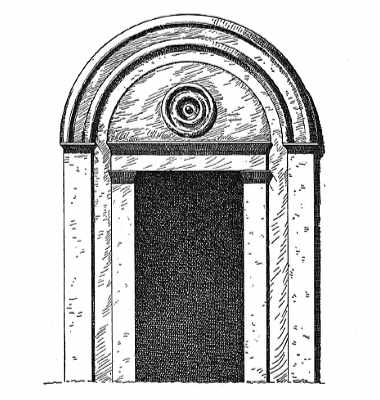
Arch tombs
Single or double arch supported by corner pilasters. Sometimes the door is also framed by pilasters with capitals that support a second arch, which may have an ornament in the middle. Tombs of this type are small.
Sources, among others:
Rudolf-Ernst Brünnow und Alfred von Domaszewski: Die Provincia Arabia, Volume 1.
Verlag Karl J. Trübner, Strasbourg 1904.
Andreas Schmidt-Colinet, Thomas Weber, Jürgen Zangenberg: "Arabischer Barock". Sepulkrale Kultur in Petra.
In: Thomas Weber, Robert Wenning (ed.), Petra - Antike Felsstadt zwischen arabischer Tradition und griechischer Norm
Verlag Phillip von Zabern, Mainz am Rhein, 1997. S. 87 - 98
Lucy Wadeson: Blick hinter die nabatäischen Grabfassaden
In: Petra. Begleitbuch zur Ausstellung "PETRA - Wunder in der Wüste. Antikenmuseum Basel und Sammlung Ludwig, 23 October 2012 - 17 March 2013. Basel 2012, pp. S. 120 - 126
Lucy Wadeson: The development of funerary architecture at Petra: the case of the facade tombs.
In: Men on the Rocks. The Formation of Nabataean Petra. Proceedings of a conference held in Berlin, 2-4 December 2011
Michel Mouton, Stephan G. Schmid (ed.). Logos Verlag Berlin, 2013, pp. 167 - 180
© Texts and photos are protected by copyright.
Compilation of information, editing, translations, photos: Universes in Universe, unless otherwise indicated
A triclinium is a dining room widely used in Antiquity with three benches (or sofas) on which the guests reclined while feasting. In Petra, more than a hundred such triclinia of various sizes have been found, about a quarter of them in connection with tombs for ritual banquets in honour of the deceased.
A biclinium is such a room with two benches.
Rudolf-Ernst Brünnow and Alfred von Domaszewski: Die Provincia Arabia, Volume 1.
Verlag Karl J. Trübner, Strasbourg 1904.
The catalogue of grave facades and other monuments in Petra, compiled by the researchers during their travels in 1897 and 1898, still serves as a reference today - abbreviated BD or Br. with the respective number.